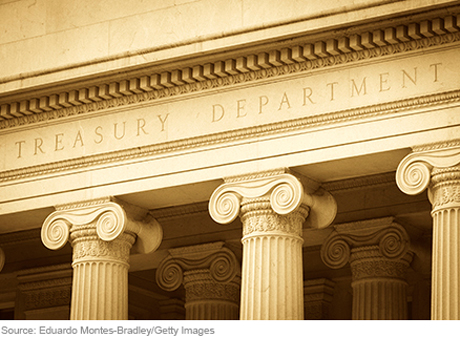Hey, Economist! Why—and When—Did the Treasury Embrace Regular and Predictable Issuance?

Few people know the Treasury market from as many angles as Ken Garbade, a senior vice president in the Money and Payments Studies area of the New York Fed’s Research Group. Ken taught financial markets at NYU’s graduate school of business for many years before heading to Wall Street to assume a position in the research department of the primary dealer division of Bankers Trust Company. At Bankers, Ken conducted relative-value research on the Treasury market, assessing how return varies relative to risk for particular Treasury securities. For a time, he also traded single-payment Treasury obligations known as STRIPS—although not especially successfully, he notes.
Monetary Policy Transmission before and after the Crisis
At the N.Y. Fed: The Transatlantic Economy: Convergence or Divergence?
On April 18, 2016, the New York Fed hosted a conference on current and future policy directions for the linked economies of Europe and the United States. “The Transatlantic Economy: Convergence or Divergence,” organized jointly with the Centre for Economic Policy Research and the European Commission, brought together U.S. and Europe-based policymakers, regulators, and academics to discuss a series of important issues: Are the economies of the euro area and the United States on a convergent or divergent path? Are financial regulatory reforms making the banking and financial structures more similar? Will this imply a convergence in macroprudential policies? Which instruments do the United States and the euro area have at their disposal to raise investment, spur productivity, and avoid secular stagnation? In this post, we summarize the principal themes and findings of the conference discussion.
Reconciling Survey‑ and Market‑Based Expectations for the Policy Rate

In our previous post [LINK], we showed that the gap between the market-implied path for the federal funds rate and the survey-implied mean expectations for the federal funds rate from the Survey of Primary Dealers (SPD) and the Survey of Market Participants (SMP) narrowed from the December survey to the January survey.
How the Fed Smoothed Quarter‑End Volatility in the Fed Funds Market
The federal funds market is an important source of short-term funding for U.S. banks.
The Effect of Fed Funds Rate Hikes on Consumer Borrowing Costs
Nina Boyarchenko, Sooji Kim, and Matthew Plosser The target federal funds rate has hovered around zero for nearly a decade, and observers are questioning what effect an increase could have on both the financial markets and the real economy. In this post, we examine the historical reaction of loan rates to target rate increases. Specifically, […]
At the New York Fed: Conference on the Evolving Structure of the U.S. Treasury Market
Michael Fleming, Frank Keane, Michael McMorrow, Ernst Schaumburg, and Nathaniel Wuerffel The New York Fed recently hosted a two-day conference on the evolving structure of the U.S. Treasury market, co-sponsored with the U.S. Department of the Treasury, the Federal Reserve Board, the U.S. Securities and Exchange Commission, and the U.S. Commodity Futures Trading Commission. The […]
The Tri‑Party Repo Market Like You Have Never Seen It Before
The tri-party repo market is a large and important market where securities dealers find a substantial amount of short-term funding. Despite its importance, this market was very opaque before the crisis. Since March 2010, in accordance with recommendation 13 of the Task Force on Tri-Party Repo Infrastructure Reform report, the Federal Reserve Bank of New York has made monthly data on the tri-party repo market available to the public. Today, with our new interactive tool, there is a whole new way to view the market and its evolution. You can make your own charts, looking at volumes for specific asset classes, at haircuts, or at concentration, over your preferred time horizon.
From the Vault: Supplementing a Monetary Policy Syllabus
Liberty Street Economics posts from New York Fed economists can serve as teaching tools for new monetary policy and lending tools that are “not found in any textbook.”
History of Discount Window Stigma
In August 2007, at the onset of the recent financial crisis, the Federal Reserve encouraged banks to borrow from the discount window (DW) but few did so.











 RSS Feed
RSS Feed Follow Liberty Street Economics
Follow Liberty Street Economics